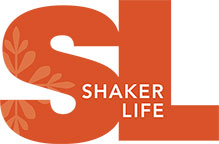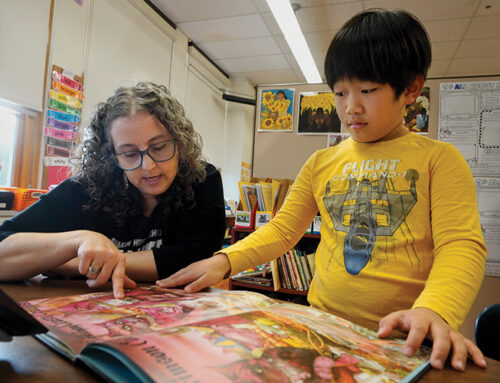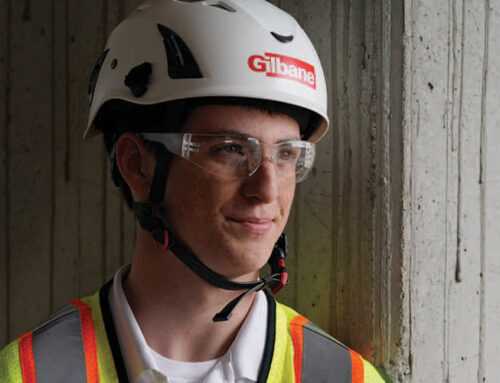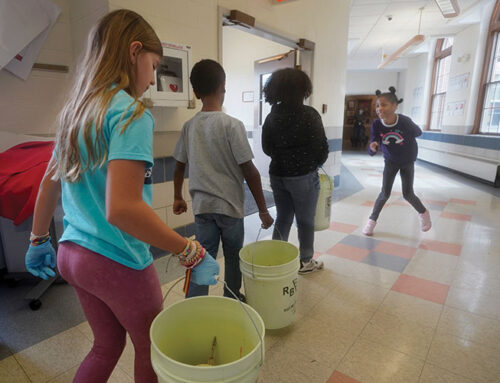Hathaway Brown’s Center for Sustainability is built around student action.
By Sharon Holbrook
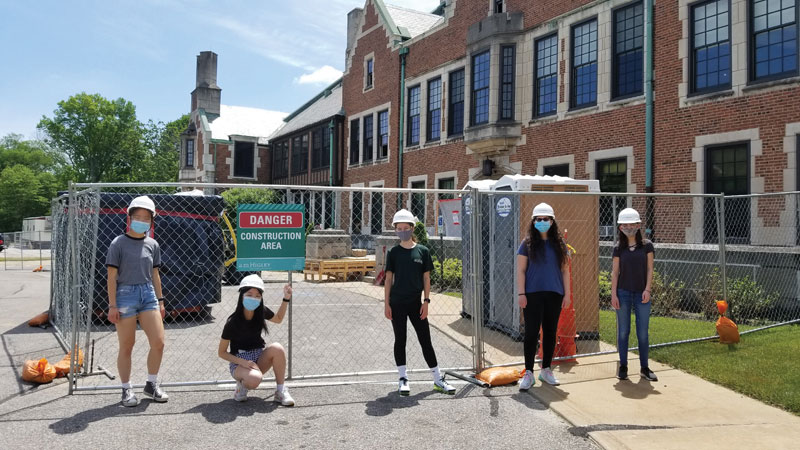
Students in 2020 served as summer interns during Hathaway Brown’s ongoing renovations.
Impressive historic buildings. Beautifully kept athletic fields. That’s an accurate first impression of Hathaway Brown School’s facilities and grounds, but there’s more than meets the eye: Quietly threading through its physical setting, curriculum, and student experiences is a growing commitment to environmental sustainability.
That focus means prioritizing sustainability in the school’s building renovations, including current work on the school’s oldest structure and upcoming work on the primary school building. There’s also the gradual shift towards permeable pavement and the planned addition of a rain garden, both of which will reduce excess stormwater runoff into nearby Doan Brook.
Even the local birds are benefiting. Sustainability was an impetus for the transformation of an underused corridor into a tucked away bird sanctuary. The protected setting, complete with native plants and numerous bird feeders, creates not only a haven for birds and pollinators but also a natural play area for young students.
While these improvements make tangible contributions to the physical campus, the heart and soul of Hathaway Brown’s Center for Sustainability are its curriculum and student action.
Fellowships: Learning in the Classroom and Beyond
At Hathaway Brown, Ohio’s oldest continuously operating college prep school for girls, the environmental focus starts with students, literally. In 1988, then-junior Torrey McMillan founded the school’s first environmental club. So it’s no wonder that when McMillan returned to HB in 2011 to become its Director of Fellowships in Sustainability, fostering student initiative and action were at the heart of her job.
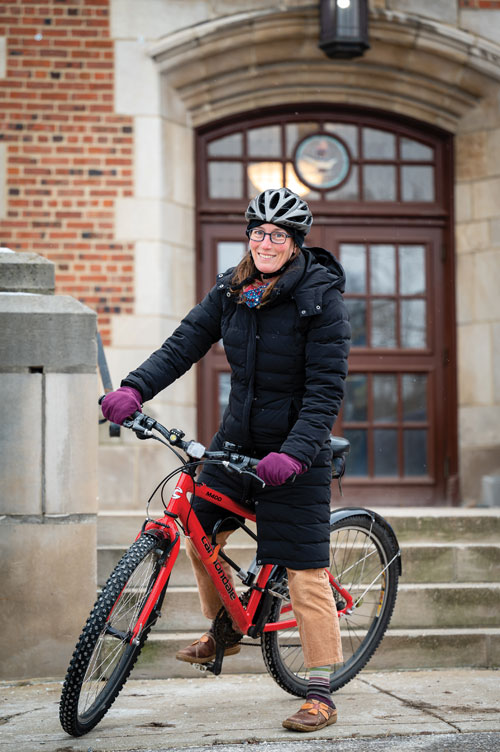
Torrey MacMillan, Director of Fellowships in Sustainability. Photo: Jason Miller
The Fellowships are a curricular option offering a combination of classroom work and experiential learning, meaning that HB girls get to help shape their own educational experience, including engagement with the world outside the classroom. (Besides Fellowships in Sustainability, Fellowships are available in eight different subjects ranging from business to equity to writing.)
All 9th grade HB students take a required Fellowship seminar, and then interested girls can either just sample upper-level fellowship classes – in Sustainability, that may include classes in political action and institutional change making – or take it even further by earning a diploma designation in one of the eight Fellowship areas. The capstone of the diploma program is a two-year project shaped by the student in which she applies her new knowledge to try to solve a problem she sees outside the classroom.
“All of these different Fellowships are designed to give students an opportunity to explore pressing issues of the day, to apply their learning in direct and meaningful ways to the world around them, and to find their voice and their interests, and figure out where they fit in the world and what they want to make of themselves,” says McMillan.
A Student-Centered Approach
The first five Sustainability Fellows graduated in 2020, and their two-year capstone projects are already making an impact. One student, for example, created a tree map of the HB campus to assist in planning tree care and future plantings. A robotics-loving student used biomimicry (that is, human builders copying successful features from the natural world) to try to reproduce the protective effect that tree canopies have in stormwater management. “The learning along the way is incredible,” says McMillan.
Currently, one Fellowship student is using her capstone project to develop the beginnings of a climate action plan for Hathaway Brown, which McMillan says has been a complex and exciting effort for the student.
“It’s really rare for a student to get this level of insight into how an institution works and to be thinking about all of the different tensions and pulls that administrators and trustees are trying to navigate,” says McMillan. “She’s getting to hear all those conversations and then infuse her own insights from the student body – how to gauge student buy-in and student interest in this.”
A diploma designation and its capstone project aren’t the only way to participate in the sustainability action. Senior Grace Zhang, co-president of the school’s Green Team club, has leapt into these other opportunities.
“I had always wanted to do something to help prevent climate change, but I really started getting involved because I kind of had an epiphany one day. I can’t always just wait for someone to do this. I have to take action myself.”
COVID-19 restrictions have made gathering the Green Team more difficult this past year, since projects have typically revolved around in-person schoolwide initiatives. But, Zhang says, the Team has found pandemic-friendly ways to connect HB students with the environment, including leading socially distant walks and hikes, engaging in community cleanup efforts, and planting native flowers in the school’s bird sanctuary.
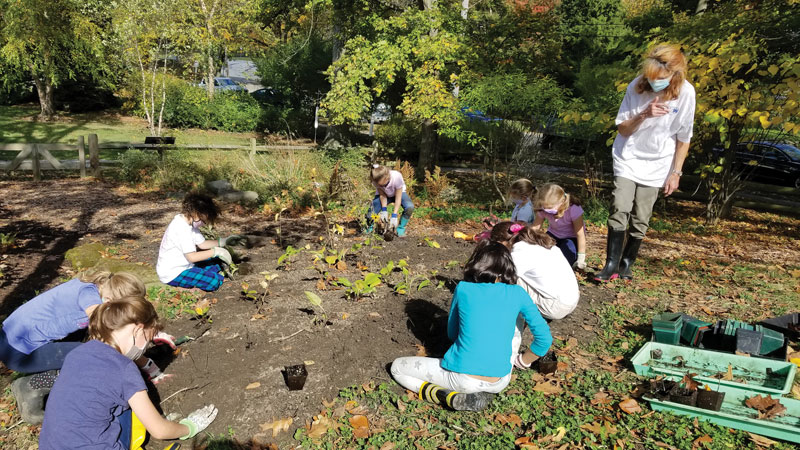
Third grade students plant native pollinators in the bird sanctuary.
As students are now beginning to come back in person, the Green Team is refocusing on campus efforts, like decreasing food waste at school and “educating people in the HB community about how they can be more sustainable with their eating habits,” she says.
This effort pairs perfectly with junior Kaila Morris’s Sustainability Fellowship capstone project, which focuses on sustainability practices in the school’s student-run café, the HathCaff. Originally conceived by some Business and Finance students at HB, students fill all company positions from the executive team to the baristas. For her two-year project, Morris is creating a Director of Sustainability position for the company. For this first year, with the café closed and school having been remote for much of the time, Morris has been focusing on research and drafting a statement of HathCaff’s sustainability practices, such as composting guidelines. Next school year, implementation will begin.
Shaker and Beyond
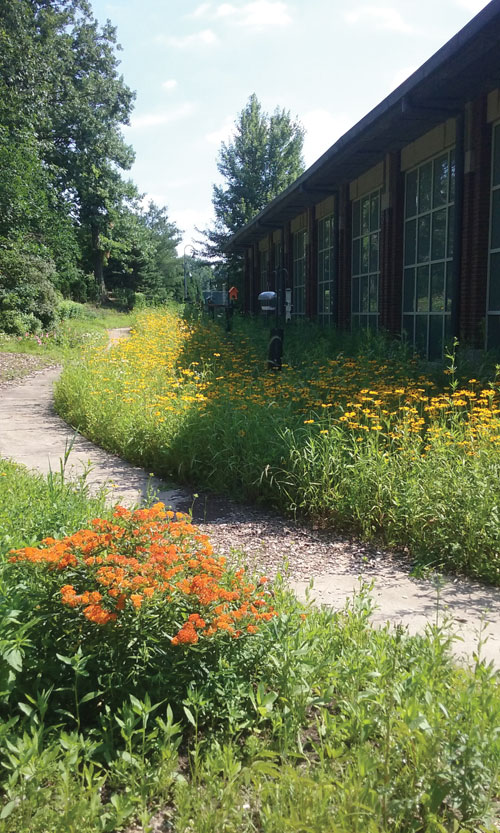
The wildflower meadow at Hathaway Brown’s bird sanctuary
HB’s action on sustainability extends beyond campus to Shaker Heights and the surrounding region. As reported in Shaker Life’s fall 2020 issue, Hathaway Brown students regularly join teens from Shaker Heights High School, Laurel School, and University School to advise the City’s Sustainability Committee, most recently on what steps the City needs to take to secure LEED certification (Leadership in Energy and Environmental Design). During the pandemic, Shaker Youth LEEDS continues to meet virtually and undertake research to assist the City.
Other students, also outside of school hours, have become involved with the Cleveland chapter of Citizens’ Climate Lobby (CCL), a nonpartisan organization that lobbies for federal policy to address climate change. Zhang and other students have participated in the organization’s summer program, and other HB students attend local meetings and manage the chapter’s Instagram account. They bring a valuable student perspective to the group, says McMillan, who volunteers her own time to head the Cleveland chapter of CCL.
With McMillan’s longstanding dedication to environmentalism and her roots as a student at HB, her return to become the Director of Sustainability might seem like a foregone conclusion. But it nearly didn’t happen. When McMillan was living in New Hampshire and searching for a new job in sustainability education, her search was national. But it just so happened that the perfect job in sustainability drew her back to her alma mater and Cleveland. “This work brings people to our region,”she says.
